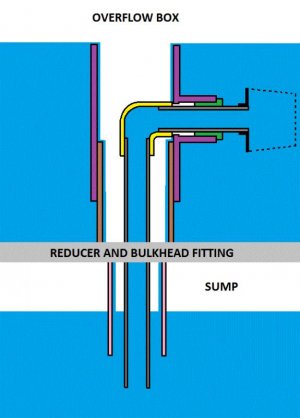Turtlesteve
New member
I wanted to share the silent overflow design I am using on my 90 gallon reef. The purpose of this was to solve some issues with other designs. Most importantly, I wanted something that really worked well for a standard drilled tank with only a single drain bulkhead.
Here's the design in cross section. This is made from standard PVC fittings. The drawing is color coded for the description below.

a) The stock stand pipe and drain (brown, pink) from the 90 gallon Marineland tank were not modified, except that the fittings at the top were removed.
b) At the top of the stand pipe, a reducing tee (purple) is added. The side port is 3/4".
c) A 3/4" to 1/2" Reducer (green) is put in the side port. About 1/4" must be cut off of the inner side of this fitting, so that 1/2" PVC pipe (dark gray) may be pushed completely through it. An intake screen is needed on the outside.
d) Inside the reducing tee is a 1/2" 90 elbow (yellow). This fitting needed a little trimming to put the downward facing opening in the center of the drain.
e) The 1/2" pipe (dark grey) extends all the way into the sump, and is 1" longer than the outer pipe. For this piece I used thin wall (schedule 20) pipe typically used for wire conduit.
f) In my case, the drain runs straight down and the sump is directly underneath the overflow. However this would theoretically work with flexible tubing as well.
The overflow design functions like the "Herbie" or "Bean animal", with a full siphon in the primary drain and a trickle down the secondary. However there are a couple differences:
- Space is critical, so the primary drain is sized perfectly to the desired flow rate (1/2" schedule 20 in this case). Therefore there is no gate valve. The flow rate is tuned in by throttling the return pump.
- The secondary (backup) drain is between the outer and inner pipes so it avoids a separate bulkhead fitting. The system can tolerate a complete blockage of the primary drain with about 60-70% blockage of the secondary. The shape of the secondary drain resists blockage as well.
I've been running this for 6 months and it's worked without issue so far. I do have to adjust the return flow rate every now and then to keep it tuned. As one final thought, it's advisable to put a screen above the overflow box as I lost one fish down the backup drain.
Hopefully this proves useful to someone.
Steve P
Here's the design in cross section. This is made from standard PVC fittings. The drawing is color coded for the description below.

a) The stock stand pipe and drain (brown, pink) from the 90 gallon Marineland tank were not modified, except that the fittings at the top were removed.
b) At the top of the stand pipe, a reducing tee (purple) is added. The side port is 3/4".
c) A 3/4" to 1/2" Reducer (green) is put in the side port. About 1/4" must be cut off of the inner side of this fitting, so that 1/2" PVC pipe (dark gray) may be pushed completely through it. An intake screen is needed on the outside.
d) Inside the reducing tee is a 1/2" 90 elbow (yellow). This fitting needed a little trimming to put the downward facing opening in the center of the drain.
e) The 1/2" pipe (dark grey) extends all the way into the sump, and is 1" longer than the outer pipe. For this piece I used thin wall (schedule 20) pipe typically used for wire conduit.
f) In my case, the drain runs straight down and the sump is directly underneath the overflow. However this would theoretically work with flexible tubing as well.
The overflow design functions like the "Herbie" or "Bean animal", with a full siphon in the primary drain and a trickle down the secondary. However there are a couple differences:
- Space is critical, so the primary drain is sized perfectly to the desired flow rate (1/2" schedule 20 in this case). Therefore there is no gate valve. The flow rate is tuned in by throttling the return pump.
- The secondary (backup) drain is between the outer and inner pipes so it avoids a separate bulkhead fitting. The system can tolerate a complete blockage of the primary drain with about 60-70% blockage of the secondary. The shape of the secondary drain resists blockage as well.
I've been running this for 6 months and it's worked without issue so far. I do have to adjust the return flow rate every now and then to keep it tuned. As one final thought, it's advisable to put a screen above the overflow box as I lost one fish down the backup drain.
Hopefully this proves useful to someone.
Steve P
